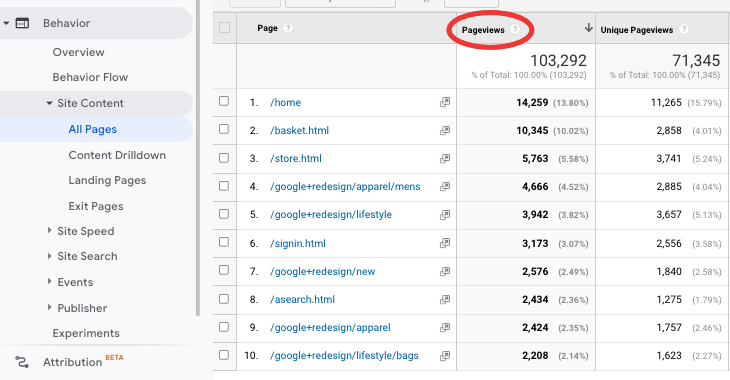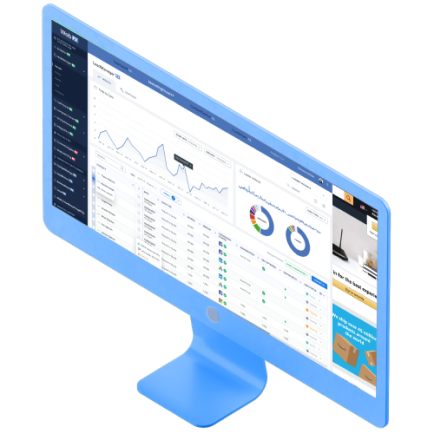-
 Published: May 30, 2022
Published: May 30, 2022
-
 7 min. read
7 min. read
-
 Kayla Johansen
Kayla Johansen Content Writer
Content Writer
- Kayla is a content specialist with a B.S. in marketing. She is certified in Google Analytics and Google Ads Search and Display. When not writing, she enjoys reading, playing with her dog, and baking.
What are impressions?
Impressions are the number of times an ad or webpage appears in search results, and they play a crucial role in measuring online visibility and potential audience reach.
You’ve probably seen the word “impressions” floating around in discussions about metrics, but you might be wondering, “what are impressions?” Impressions are the opportunities your content has to be seen by someone. If your content loaded or appeared on a page, that can count as an impression.
You can measure impressions for any piece of digital content, from pages on your site to social media posts and ads. Examples of impressions across the content types include:
- How many times your pay-per-click (PPC) ad appeared in search results
- How many times your social media post or ad appeared in someone’s feed
- How many page views your website content received
- How many times your page appeared in organic search results
While impressions alone aren’t enough to inform your marketing strategy or reveal how well content is performing — for instance, you should also look at clicks — they can still provide a practical starting point for measuring brand awareness campaigns and whether your content is gaining traction.
Ready to learn more about how impressions are measured and why and how you can use this metric alongside others? Keep reading for a deep dive into what impressions are!
And while you’re here, subscribe to Revenue Weekly to get more digital marketing insights like this delivered straight to your inbox!
How are impressions measured?
Now that you know the answer to “what are impressions,” let’s take a deeper dive into how impressions are measured.
Understanding the process will help you see how impressions differ from similar metrics and why you should reference your impression counts alongside other metrics.
Served vs. viewable impressions
Online impressions can be measured in two ways: Served and viewable.
Served impressions count the times a piece of content — often an ad — was loaded. These impressions could count instances in which a user didn’t view the ad because they were using ad blockers or didn’t view the part of the page on which the ad loaded.
Meanwhile, viewable impressions account for those instances and only tally a new impression when the user most likely saw the ad.
Impressions vs. reach
With all this talk about what impressions are, you might have noticed some similarities with another standard metric — reach. Both impressions and reach measure content views, but reach measures unique views.
In other words, impressions can increase when the same person sees your content multiple times, but your reach will only increase when someone new sees your content.
Learn more about impressions vs. reach in this blog post
What are impressions on various platforms?
You can find impression counts for different types of content on many platforms. Broken down by content type, platforms will measure and depict your online impressions in the following ways:
Social media impressions
Most social platforms measure your impressions as views, but Facebook tracks impressions differently.
Facebook includes three types of impressions: organic, paid, and viral. Organic impressions track views for your organic Facebook posts, paid impressions measure views for paid posts, and viral impressions count those earned when someone else shares your content.
Facebook Ads also tells you the number of served and viewed impressions your ads received.
PPC impressions
While monitoring your PPC campaigns in Google Ads, you can track your standard impression count alongside multiple related metrics, including:
- Impression percentage: Google Ads will give you two impression percentage counts that track how many of your total impressions appeared in the first position or any position above the organic search results.

- Impression share: You’ll also receive two impression share counts that track the impressions you earned in a given position as a percentage of the possible impressions you could have received in that position.
Website impressions
You can also track impressions your website receives through Google Analytics and other tools. These platforms measure impressions as:
- Pageviews: In Google Analytics, you can see the number of views each page on your site receives. In practice, this metric tracks your page impressions.

- Organic search impressions: Google Search Console tracks the number of impressions your pages receive in organic search results. In other words, the platform measures how many times Google showed your page to a searcher.
Factors that influence impression counts
Any discussion about impression measurement should acknowledge the factors that can influence your impression counts and make them less accurate.
I’ve already mentioned some issues affecting served impressions, but you should also consider that bots might “view” your content and drive up the numbers.
Additionally, impressions will count multiple views by the same person as a new hit. As a result, you could receive numerous impressions from someone refreshing a page or seeing the same content shared multiple times.
In some ways, repetition can increase the effectiveness of your messaging, so these apparent “duplicate” views could be helpful. But if you want to measure how many people see your content, you’ll likely want to track reach.
Why should you track impressions?
Even with its limitations, tracking impressions can boost your digital marketing strategy and inform your decisions.
If one of your marketing goals is increasing brand awareness, impressions are a valuable metric to track. These numbers — when used alongside reach — will tell you how many times potential target customers see your brand’s message.
Social media platforms even allow you to run ad campaigns on a cost-per-thousand-impressions (CPM) basis.
Impressions also serve as an effective supplemental metric for other campaign goals, such as:
- PPC campaigns: You could track each impression vs. click you receive for PPC ads. If your ad has a high impression percentage — meaning Google is consistently serving your ad in a top position — with a low click-through rate (CTR), you might need to re-optimize your ad for conversions.
- Social media: For your social media content to drive results, users must see it in their feeds. Measure impressions to track how many people see your posts, and supplement these findings with engagement metrics to gauge whether those people respond to your content.
- Search engine optimization (SEO): Track your SEO performance by measuring your impressions in Google Search Console. You’ll also want to measure each impression vs. click you receive to calculate your CTR alongside other relevant conversion metrics for a complete picture of your pages’ performance.
Ultimately, tracking impressions and additional metrics depends on your marketing goals. Each business and campaign will require different metrics for the most effective results.
How can you increase your impressions?
As you begin tracking your impressions, you might find room for improvement. If that’s the case, check out these quick tips for increasing your impressions:
- Improve engagement: From social media to search engines, all platforms want to serve their users content they appreciate. So, if you want platforms to display your content for more impressions, track your engagement and focus on ways to improve those metrics.
- Create targeted content: One of the best ways to improve engagement is to create targeted content. Use the targeting capabilities available in your advertising platform, and optimize your content for keywords relevant to your audience.
- Run A/B tests: If you want real-time data to inform your decisions, test your ads and social media content to determine which content types and formats receive the most engagement and impressions.
- Improve ad quality and bids: Google Ads determines which ads they show based on your bid amount and ad quality. Learn how to optimize your PPC ads (and how to improve your Google Ads Quality Score) for impressions by improving these elements.
- Follow SEO best practices: If you want to increase your organic search impressions, focus on SEO, including on-page, off-page, and technical SEO.
Meet MarketingCloudFX:
One platform tracking countless metrics and driving stellar results.
Learn More About Our Proprietary Software

Track the metrics that matter most to your business
A robust data-tracking strategy helps you drive more results for your business, and impressions are just one piece of the puzzle. At WebFX, we provide a holistic tracking platform to help you measure and analyze all the metrics you need for your campaigns.
MarketingCloudFX measures critical business markers like:
- Audience interactions
- Leads generated
- Content analytics
- Email metrics
- Return on investment (ROI)
- And more
To simplify your data tracking process, we make all these metrics available to you in one user-friendly platform.
Ready to learn more about how MarketingCloudFX will help you track the metrics that matter most to your business? Call us at 888-601-5359 or contact us online to speak with a strategist today!
-
 Kayla is a content specialist with a B.S. in marketing. She is certified in Google Analytics and Google Ads Search and Display. When not writing, she enjoys reading, playing with her dog, and baking.
Kayla is a content specialist with a B.S. in marketing. She is certified in Google Analytics and Google Ads Search and Display. When not writing, she enjoys reading, playing with her dog, and baking. -

WebFX is a full-service marketing agency with 1,100+ client reviews and a 4.9-star rating on Clutch! Find out how our expert team and revenue-accelerating tech can drive results for you! Learn more
Try our free Marketing Calculator
Craft a tailored online marketing strategy! Utilize our free Internet marketing calculator for a custom plan based on your location, reach, timeframe, and budget.
Plan Your Marketing Budget

Maximize Your Marketing ROI
Claim your free eBook packed with proven strategies to boost your marketing efforts.
Get the GuideTry our free Marketing Calculator
Craft a tailored online marketing strategy! Utilize our free Internet marketing calculator for a custom plan based on your location, reach, timeframe, and budget.
Plan Your Marketing Budget





